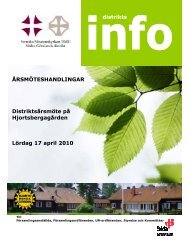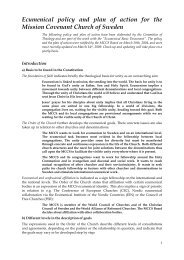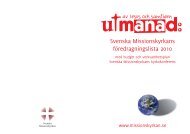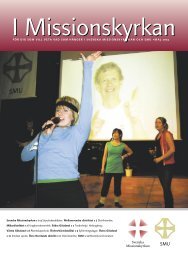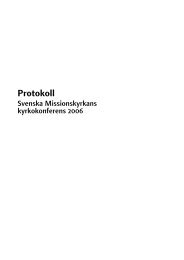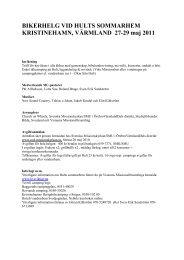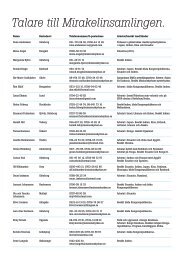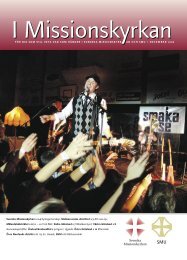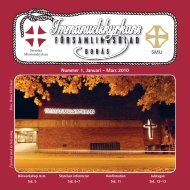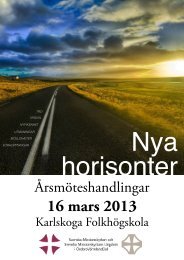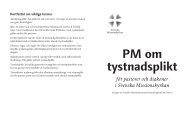Mission and Revolution in Central Asia - Svenska Missionskyrkan
Mission and Revolution in Central Asia - Svenska Missionskyrkan
Mission and Revolution in Central Asia - Svenska Missionskyrkan
Create successful ePaper yourself
Turn your PDF publications into a flip-book with our unique Google optimized e-Paper software.
III. The Foundation 1901 – 1912.<br />
From the Boxer Upris<strong>in</strong>g to the Birth of the Republic<br />
As has already been suggested, the turn of the century was characterized by concern <strong>and</strong><br />
uncerta<strong>in</strong>ty for the <strong>Mission</strong>. Hesitation <strong>and</strong> caution held the missionaries back from more<br />
extensive efforts. Moreover the two missionary couples Högberg <strong>and</strong> Raquette were both<br />
back home <strong>in</strong> Sweden dur<strong>in</strong>g the first years of the 20 th century. The <strong>Mission</strong> was “worn out”,<br />
<strong>and</strong> when Bäcklund came to Kashgar <strong>in</strong> 1900 “it was shattered”. But the remarkable<br />
expansion that missionary efforts <strong>in</strong> Ch<strong>in</strong>a on the whole was to experience after the Boxer<br />
Upris<strong>in</strong>g was also to be seen <strong>in</strong> Eastern Turkestan. The plann<strong>in</strong>g for the mission work was<br />
soon <strong>in</strong> full sw<strong>in</strong>g. The era of foundation had arrived. New missionaries are sent out, activities<br />
with<strong>in</strong> medical care <strong>and</strong> orphanages are exp<strong>and</strong>ed. The Ch<strong>in</strong>ese branch of the mission work<br />
develops. This period also harbours a magnificent “Bible dispute”. This section comes to an<br />
end with the Ch<strong>in</strong>ese <strong>Revolution</strong> that reached Kashgar <strong>in</strong> 1911-1912.<br />
A summary of this period shows that Waldenström came to be of decisive importance for<br />
the missionaries <strong>in</strong> several important issues. What is also made clear is the difficulty for the<br />
<strong>Mission</strong> to w<strong>in</strong> <strong>Asia</strong>ns for the Christian faith. The summary also gives evidence to the fact<br />
that the <strong>Mission</strong> activity dur<strong>in</strong>g this period establishes itself as a work of <strong>in</strong>stitutions. The path<br />
chosen for the work dur<strong>in</strong>g these years came to be decisive for the whole missionary era. A<br />
foundation was built, <strong>and</strong> on that foundation the work was cont<strong>in</strong>ued.<br />
1. New <strong>Mission</strong>aries Keep Com<strong>in</strong>g to the Field <strong>in</strong> a Constant Stream.<br />
The “old” missionaries, Högberg <strong>and</strong> Raquette <strong>and</strong> their wives, received 20 new collaborators<br />
dur<strong>in</strong>g this period. Albert Andersson <strong>and</strong> his wife Maria Lovisa arrived at the turn of the year<br />
1900-1901 together with Lovisa Engvall. In 1903 Adolf Bohl<strong>in</strong> <strong>and</strong> Elsa Svensson (later to<br />
become Mrs Törnquist) arrived, <strong>and</strong> <strong>in</strong> 1904, John Törnquist. Elsa Andersson <strong>and</strong> Hilda<br />
Nordqvist arrived <strong>in</strong> 1906 <strong>and</strong> the year after, St<strong>in</strong>a Mårtensson <strong>and</strong> El<strong>in</strong> Svensson. David<br />
Gustafsson <strong>and</strong> Oskar et Gerda Andersson (brother <strong>and</strong> sister) <strong>in</strong> 1908 <strong>and</strong> Rikard Nyström,<br />
Gottfrid Palmberg <strong>and</strong> Maria (Mia) Mobeck 1910. In 1911, Gustaf Adolf Arell, Helena<br />
Lundahl (later on married to Nyström) <strong>and</strong> <strong>in</strong> 1912 Hanna Larsson (later on married to Arell)<br />
<strong>and</strong> Gustaf Ahlbert. Dur<strong>in</strong>g the whole missionary era, 24 male <strong>and</strong> 36 female missionaries<br />
were sent out, all <strong>in</strong> all 60 persons. So those above mentioned make up not less than a third of<br />
the whole number of missionaries.<br />
A considerable number of missionaries rema<strong>in</strong>ed s<strong>in</strong>gle which created some problems.<br />
Muslims have no respect for an un-married woman. Accord<strong>in</strong>g to them, she is necessarily a<br />
whore. Furthermore, it was not considered appropriate to station a s<strong>in</strong>gle woman <strong>and</strong> a s<strong>in</strong>gle<br />
man at the same mission station. If that happened, evil rumours rapidly went around among<br />
the population. Not even if they were engaged to be married, <strong>and</strong> the marriage would take<br />
place <strong>in</strong> a very short period of time, was it considered acceptable that they lived <strong>in</strong> the same<br />
place. Palmberg for <strong>in</strong>stance had his fiancée <strong>in</strong> the field, but he did not dare to have her near<br />
him but was obliged to live alone at the mission station <strong>in</strong> Jarkend. 1 Problems could arise<br />
already on the journey out to the mission field. The MCCS regulations concern<strong>in</strong>g marriage,<br />
stipulat<strong>in</strong>g that missionaries had to spend three years <strong>in</strong> the mission field before marry<strong>in</strong>g<br />
caused a lot of trouble <strong>in</strong> Eastern Turkestan. The workers <strong>in</strong> the field compla<strong>in</strong>ed on several<br />
occasions about the fact that the <strong>Mission</strong> had so few married couples. They expressed for<br />
<strong>in</strong>stance their disappo<strong>in</strong>tment at the fact that Bohl<strong>in</strong> came back s<strong>in</strong>gle. 2<br />
1 Palmberg to Sjöholm, April 4th, 1914.<br />
2 Albert Andersson to Sjöholm, September 9 th , 1910.<br />
1



